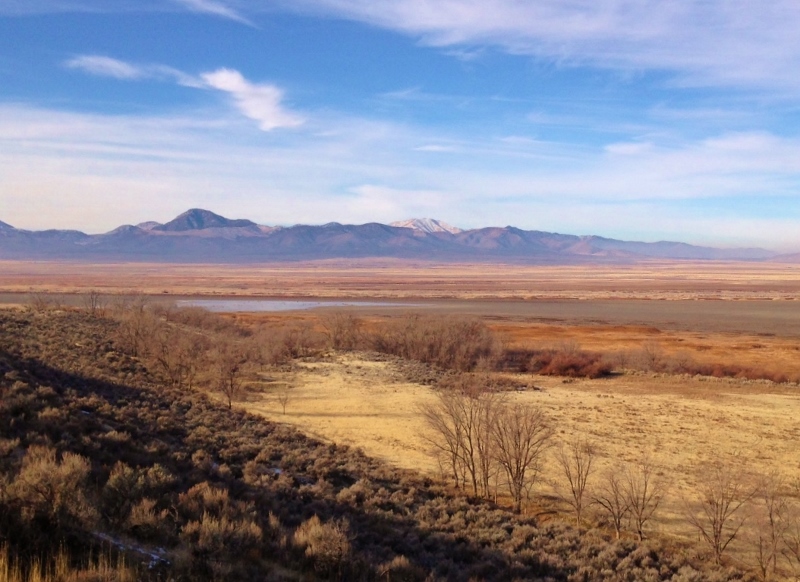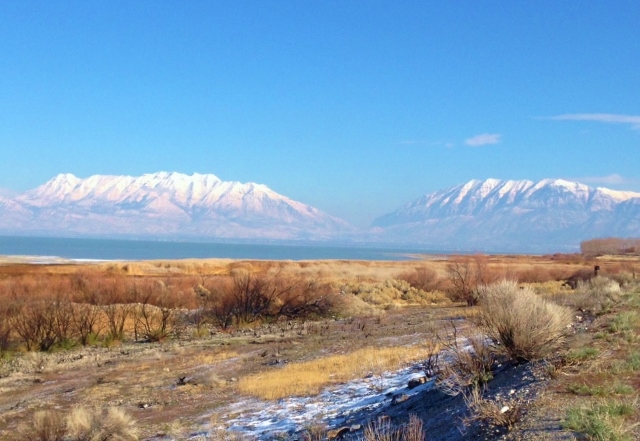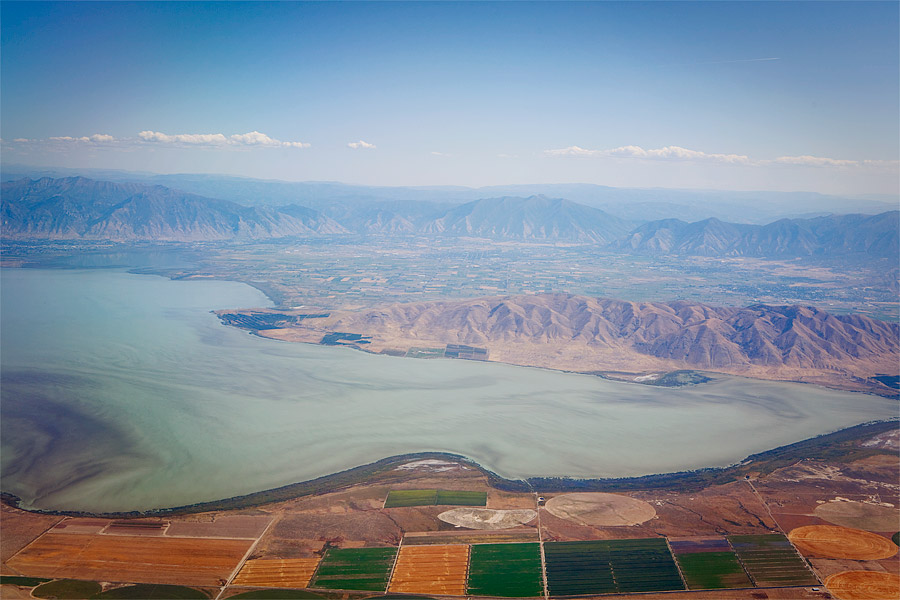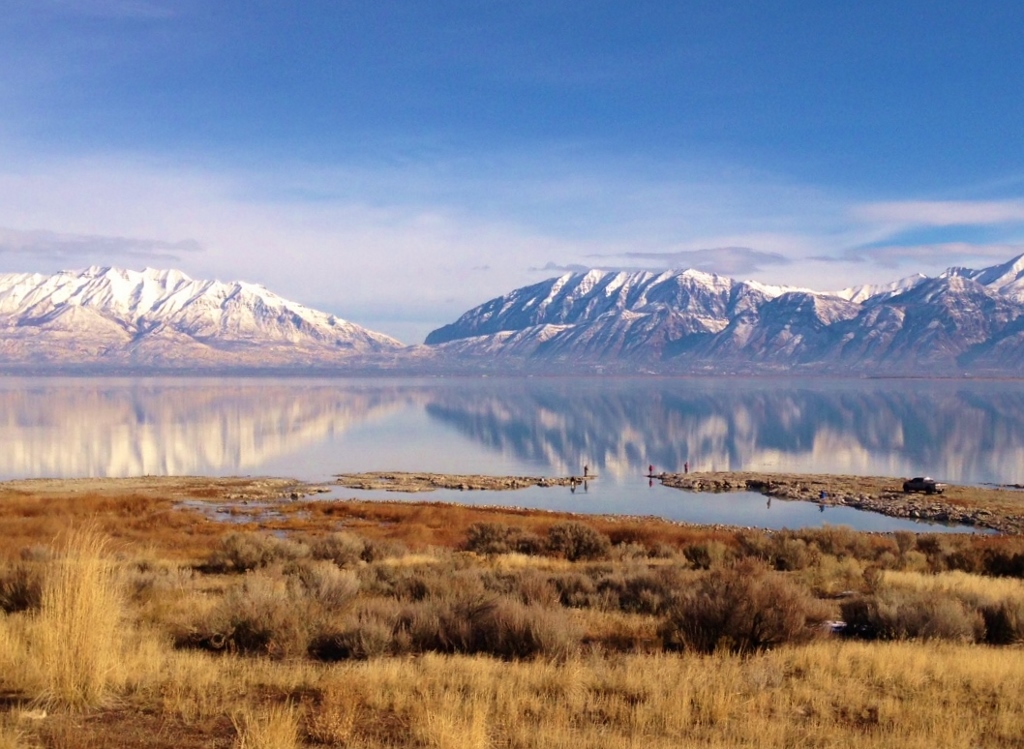Utah Lake is the largest freshwater lake in Utah. Many rivers, streams, and creeks flow into it and there is only one outlet near my home, the Jordan River which flows to the Great Salt Lake. Utah Lake is 12 miles across at its widest point and about 21 miles long. This year the lake is at its 2nd lowest level in over 50 years because so much water was allowed to flow out of it during the summer for irrigation. The lake is very shallow with the maximum depth this year about 9 feet with the average less than 5 feet deep.
Each year hundreds of cyclists ride all the way around Utah Lake using a 100-mile route for a “century” ride. There is no established trail that runs near the shores of the lake, so roads are used. Most of the route around the lake is rural farm land with the exception of about ten miles on the east side through the Provo-Orem metropolitan area.
As far as I know, I’m the only person who has run all the way around it, with a route of about 85 miles. I’ve run around it twice. I looked forward to running around it again and with the low lake level, try some cross-country bushwhacking on the south end to reduce the miles.
I left the house and 2:20 a.m. and was very surprised that a heavy snow storm was hitting. I had not expected this, but knew it had to be a small squall that would pass. But it slowed me down quite a bit, running the first few miles at about 11:30 pace heading south on the west side of the lake. The snow storm passed, but had dumped two inches on the road for my first ten miles. A snow plow came by and slowed down carefully around me. I’m sure he thought I was nuts.
At the four-mile mark I had the road mostly to myself after passing by the furthest housing development. I next ran by a gravel pit with trucks coming a going, a massive dairy farm, and quiet massive ranches. Above me the sky was now clear and Orion was shining ahead of me.
At about the 18-mile mark, a ranch dirt road parallels the highway, so I jumped on it to give my legs a break. It was pretty frigid, about 25 degrees, but thankfully the slight breeze was at my back.
At mile 19.5, I goofed and in the dark took the wrong branch of the dirt road and started heading away from the highway. After a half mile, I decided that I should probably get back on the highway, so I turned to reach it by running cross-country across a snow-covered field. But it wasn’t a field, it was an ice-covered mud-filled wide irrigation canal. After a few steps, I broke through the ice and was up to my knees in thick mud. To make things worse, it was like quick sand. The more I moved, the deeper I went and it had a great hold on my feet trying to claim my shoes. I knew that I was in a tough spot, so quit moving and sinking deeper. I laid on my back to take weight off my feet, and my back also broke through the ice. I struggled for several minutes but finally was able to free my feet without losing my shoes, and carefully scooted back to the solid bank.
I got back on the dirt road and looked at the damage. Both my water bottles had been submerged into the thick mud and also my Garmin watch. My shoes were both huge globs of mud. What should I do? Should I bail out and call my wife to pick me up? I did my best to remove one layer of mud and started walking to kick the mud off my shoes. I reached the Mosida handcart road and stopped at a porto potty there. I used a bunch of toilet paper to wipe mud off me. It was terrible, what a blunder! I decided to continue on, but it was really annoying. I kept wiping mud all over my face with my muddy mittens. It would be embarrassing if anyone saw me.
On I went. At the 24.7-mile mark, at dawn, I left the road to attempt my cross country short-cut around the south side of the lake. This would be an interesting adventure. For the first mile, there was a nice dirt road to follow, but it ended at what should be the shoreline of the lake in high water years. The way ahead was long stretches of weeds to dodge. They were usually low, but some stretches were really annoying with high weeds. My pace was slow, about 17-minute miles, but my route was cutting off a bunch of miles. I looked down to my legs and shoes and was amazed to see that all the weeds I had been running through had scraped off all the mud.

As I neared the shore of West Mountain I came upon a large mud flat covered in fine snow. The mud was firm and frozen so I made great time. But my greatest challenge was to get out of the dry lake bed up onto the firm shore. I had to make my way through tall swampy, thick reeds more than ten feet high wading through ankle deep water. Finally at mile 30 and nearly seven hours into my run I got through the reeds and was up on a firm dirt road on the west side of West Mountain.

Five miles later, I decided to stop, eat, clean up some more, and let my wife know that I was fine. It was warming up a little and I decided to ditch my mud-covered outer jacket and my mud-covered mittens (I had two pair of clean gloves). I hid them to be picked up later. Finally free of most of the mud I felt much better and increased my pace on the paved Lincoln Beach road that goes around West Mountain. (I’ve run around West Mountain a couple previous times so was familiar with the route.)

My problem was fluids. My water bottles had frozen up pretty bad, but I managed to get slush and ice out of them. That icy fluid was nearly gone. I still had 20 miles to civilization. I saw a guy at his car on the shoreline. He had just come back from wading in the lake. I approached him and asked if he had water to spare. Thankfully he did and I filled up my muddy frozen water bottles. I asked what he was catching and was surprised that his answer was, “plankton.” He was out testing the health of the lake which was hit pretty hard during the summer from algae bloom. He wasn’t surprised at all to see me running and muddy.
On my way again, my route was on rural paved roads, heading northeast to reach I-15. The late morning and early afternoon was pleasant, still around 30 degrees, but the sun was out. I had lots to look at as I ran past many farms. At mile 52, after about 12.5 hours, I stopped for my first long rest at a Subway store. I cleaned up some more in the restroom and then chowed down on a sandwich.
Feeling much better, I pushed on ahead, heading north on the east side of the lake on a frontage road near the freeway. A cold breeze was now pushing against me, making it feel frigid again, sapping my energy and desire to continue. I took a known short cut across a field with curious cows and reached Provo on 500W. The sun was setting, it was getting pretty cold. I had lost my desire to finish this run with about six more hours in the bitter cold after dark. So I headed for the train station in Provo and decided to call it quits. I boarded the train and chuckled when no one wanted to sit near me when many boarded the train at the next stop. My wife picked me up at American Fork and took me home.
So I wimped out and didn’t finish the remaining 23 miles. But when I woke up the next morning, I decided to go get the remaining miles done. My wife drove me to the Provo train station and at 10:30 a.m. I continued my run, half of it along busy urban roads. My pace was good, averaging 11:00-minute miles but it was still quite chilly with no sun out. I stopped several times at convenient stores to warm up for a few minutes and ate lunch at Jimmy John’s in American Fork. The final miles were 22.6 miles and they took me 4:45 including stops.
My total route around Utah Lake was 79.8 miles this time. I believe I could still cut off about five more miles, but that will wait until next time if the lake is still low.
It had been quite an adventure with the mud bog mishap and the long bushwhack on the south end, but I had a great time. It was also great training for Across the Years in a month.




